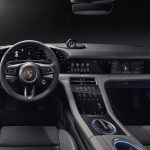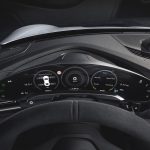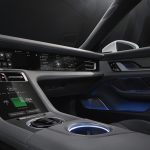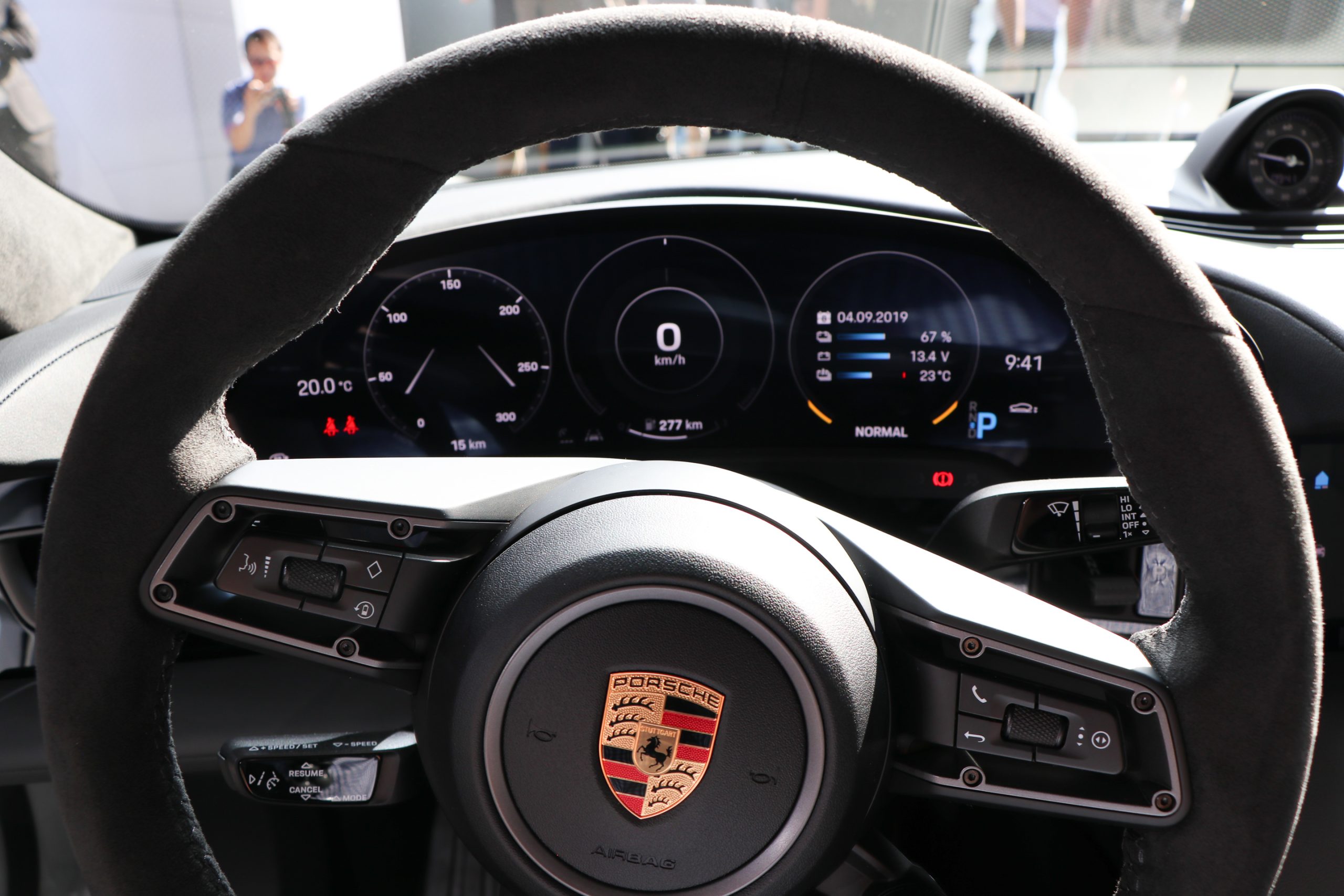
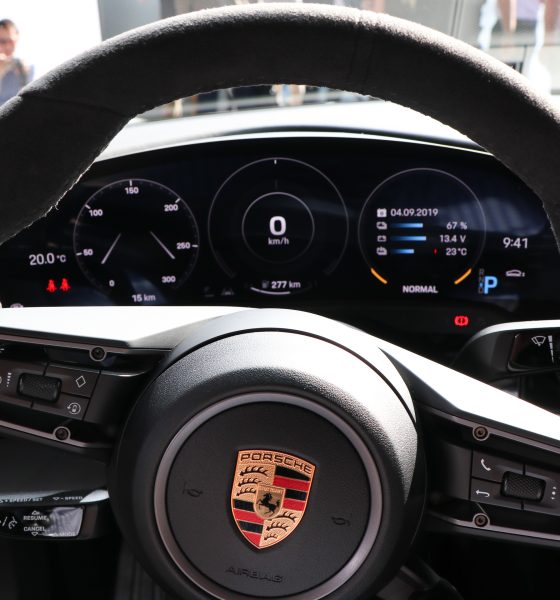
News
Porsche Taycan’s touchscreens are not like Tesla’s, but that’s a good thing
Porsche has released teaser images of the Taycan’s interior, and the reception from the electric vehicle community has been somewhat mixed. The cabin of the upcoming all-electric sports car is arguably the most forward-thinking among Porsche’s lineup. It is also not difficult to see that the German carmaker adopted a theme that is notably different compared to Tesla’s ubiquitous and minimalistic cabin, but that is a good thing.
When Porsche was designing the Taycan, the company was not designing a vehicle like the Model 3. Instead, the company was designing an electric Porsche. In this sense, a degree of familiarity is needed, especially considering that among the Taycan’s target demographic are people that have long embraced the company’s other vehicles, such as the iconic 911.
This is a notable point, considering that the community’s aversion to the Taycan’s dash layout seemed to be due to the number of buttons and icons across the vehicle’s multiple touchscreens. Some comments noted that the only difference between the controls of the Taycan and something more traditional like the Cayenne is that the buttons are now touch-based instead of mechanical.
- Porsche Taycan interior 5 touchscreens center armrest cupholders | Credit: Porsche
- Porsche Taycan curved digital touchscreen instrument cluster | Credit: Porsche
- Porsche Taycan center touchscreens armrest cupholders | Credit: Porsche
The Porsche Taycan is equipped with five touchscreens. Its instrument cluster, which has four Driving Modes, consists of a curved, rounded 16.8″ display with touch-enabled buttons on the sides. This is complemented by a central 10.9″ infotainment screen and a secondary display for the front passenger. An 8.4″ touch panel with haptic feedback stands as the Taycan’s fourth touchscreen, while a fifth, optional 5.9″ display is also available for rear-seat passengers to adjust climate control and other settings.
Porsche intends to adopt an aggressive rollout of electric and electrified vehicles in the near future, with the Taycan being the car to lead the charge. The Taycan must then strike a balance between traditional and progressive. Having a series of touch-based controls that are relatively similar to the controls the Porsche 911 and its other fleet of vehicles helps this case. Apart from this, the company has also highlighted that the Taycan’s touch displays are customizable, which means that drivers could adopt a more streamlined theme to their vehicles’ multiple touchscreens as needed. Having a fully digital display also gives Porsche the ability to gradually, and strategically, institute changes to its user interface design through software updates, and in a way that eases its audience into the age of modern user experiences.
But as it stands now, there is a certain degree of familiar ergonomics that is provided with the Taycan’s multiple touch displays. The optional touch panel on the passenger side, for one, allows passengers to navigate the vehicle’s functions without leaning over to the center console. The haptic feedback on the display at the center console is easily accessible from the passenger seat as well.
Ultimately, credit is due to Porsche for putting a notable amount of effort in developing a custom touch-based control system for the Taycan. It may not have the distinctly Silicon Valley-esque theme that is present in the Model 3, but the Taycan’s multiple digital touch-based controls show serious effort. It is, if any, notably better than the dual-screen infotainment system on the Audi e-tron, which appears to have been directly derived from an internal combustion vehicle.

Elon Musk
Elon Musk’s X will start using a Tesla-like software update strategy
The initiative seems designed to accelerate updates to the social media platform, while maintaining maximum transparency.

Elon Musk’s social media platform X will adopt a Tesla-esque approach to software updates for its algorithm.
The initiative seems designed to accelerate updates to the social media platform, while maintaining maximum transparency.
X’s updates to its updates
As per Musk in a post on X, the social media company will be making a new algorithm to determine what organic and advertising posts are recommended to users. These updates would then be repeated every four weeks.
“We will make the new 𝕏 algorithm, including all code used to determine what organic and advertising posts are recommended to users, open source in 7 days. This will be repeated every 4 weeks, with comprehensive developer notes, to help you understand what changed,” Musk wrote in his post.
The initiative somewhat mirrors Tesla’s over-the-air update model, where vehicle software is regularly refined and pushed to users with detailed release notes. This should allow users to better understand the details of X’s every update and foster a healthy feedback loop for the social media platform.
xAI and X
X, formerly Twitter, has been acquired by Elon Musk’s artificial intelligence startup, xAI last year. Since then, xAI has seen a rapid rise in valuation. Following the company’s the company’s upsized $20 billion Series E funding round, estimates now suggest that xAI is worth tens about $230 to $235 billion. That’s several times larger than Tesla when Elon Musk received his controversial 2018 CEO Performance Award.
As per xAI, the Series E funding round attracted a diverse group of investors, including Valor Equity Partners, Stepstone Group, Fidelity Management & Research Company, Qatar Investment Authority, MGX, and Baron Capital Group, among others. Strategic partners NVIDIA and Cisco Investments also continued support for building the world’s largest GPU clusters.
News
Tesla FSD Supervised wins MotorTrend’s Best Driver Assistance Award
The decision marks a notable reversal for the publication from prior years, with judges citing major real-world improvements that pushed Tesla’s latest FSD software ahead of every competing ADAS system.

Tesla’s Full Self-Driving (Supervised) system has been named the best driver-assistance technology on the market, earning top honors at the 2026 MotorTrend Best Tech Awards.
The decision marks a notable reversal for the publication from prior years, with judges citing major real-world improvements that pushed Tesla’s latest FSD software ahead of every competing ADAS system. And it wasn’t even close.
MotorTrend reverses course
MotorTrend awarded Tesla FSD (Supervised) its 2026 Best Tech Driver Assistance title after extensive testing of the latest v14 software. The publication acknowledged that it had previously criticized earlier versions of FSD for erratic behavior and near-miss incidents, ultimately favoring rivals such as GM’s Super Cruise in earlier evaluations.
According to MotorTrend, the newest iteration of FSD resolved many of those shortcomings. Testers said v14 showed far smoother behavior in complex urban scenarios, including unprotected left turns, traffic circles, emergency vehicles, and dense city streets. While the system still requires constant driver supervision, judges concluded that no other advanced driver-assistance system currently matches its breadth of capability.
Unlike rival systems that rely on combinations of cameras, radar, lidar, and mapped highways, Tesla’s FSD operates using a camera-only approach and is capable of driving on city streets, rural roads, and freeways. MotorTrend stated that pure utility, the ability to handle nearly all road types, ultimately separated FSD from competitors like Ford BlueCruise, GM Super Cruise, and BMW’s Highway Assistant.
High cost and high capability
MotorTrend also addressed FSD’s pricing, which remains significantly higher than rival systems. Tesla currently charges $8,000 for a one-time purchase or $99 per month for a subscription, compared with far lower upfront and subscription costs from other automakers. The publication noted that the premium is justified given FSD’s unmatched scope and continuous software evolution.
Safety remained a central focus of the evaluation. While testers reported collision-free operation over thousands of miles, they noted ongoing concerns around FSD’s configurable driving modes, including options that allow aggressive driving and speeds beyond posted limits. MotorTrend emphasized that, like all Level 2 systems, FSD still depends on a fully attentive human driver at all times.
Despite those caveats, the publication concluded that Tesla’s rapid software progress fundamentally reshaped the competitive landscape. For drivers seeking the most capable hands-on driver-assistance system available today, MotorTrend concluded Tesla FSD (Supervised) now stands alone at the top.
News
Elon Musk’s Grokipedia surges to 5.6M articles, almost 79% of English Wikipedia
The explosive growth marks a major milestone for the AI-powered online encyclopedia, which was launched by Elon Musk’s xAI just months ago.

Elon Musk’s Grokipedia has grown to an impressive 5,615,201 articles as of today, closing in on 79% of the English Wikipedia’s current total of 7,119,376 articles.
The explosive growth marks a major milestone for the AI-powered online encyclopedia, which was launched by Elon Musk’s xAI just months ago. Needless to say, it would only be a matter of time before Grokipedia exceeds English Wikipedia in sheer volume.
Grokipedia’s rapid growth
xAI’s vision for Grokipedia emphasizes neutrality, while Grok’s reasoning capabilities allow for fast drafting and fact-checking. When Elon Musk announced the initiative in late September 2025, he noted that Grokipedia would be an improvement to Wikipedia because it would be designed to avoid bias.
At the time, Musk noted that Grokipedia “is a necessary step towards the xAI goal of understanding the Universe.”
Grokipedia was launched in late October, and while xAI was careful to list it only as Version 0.1 at the time, the online encyclopedia immediately earned praise. Wikipedia co-founder Larry Sanger highlighted the project’s innovative approach, noting how it leverages AI to fill knowledge gaps and enable rapid updates. Netizens also observed how Grokipedia tends to present articles in a more objective manner compared to Wikipedia, which is edited by humans.
Elon Musk’s ambitious plans
With 5,615,201 total articles, Grokipedia has now grown to almost 79% of English Wikipedia’s article base. This is incredibly quick, though Grokipedia remains text-only for now. xAI, for its part, has now updated the online encyclopedia’s iteration to v0.2.
Elon Musk has shared bold ideas for Grokipedia, including sending a record of the entire knowledge base to space as part of xAI’s mission to preserve and expand human understanding. At some point, Musk stated that Grokipedia will be renamed to Encyclopedia Galactica, and it will be sent to the cosmos.
“When Grokipedia is good enough (long way to go), we will change the name to Encyclopedia Galactica. It will be an open source distillation of all knowledge, including audio, images and video. Join xAI to help build the sci-fi version of the Library of Alexandria!” Musk wrote, adding in a later post that “Copies will be etched in stone and sent to the Moon, Mars and beyond. This time, it will not be lost.”
